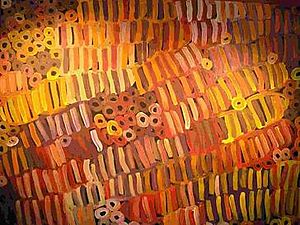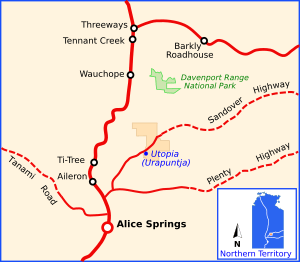Minnie Pwerle facts for kids
Quick facts for kids
Minnie Pwerle
|
|
|---|---|
| Born | between 1910 and 1922 |
| Died | 18 March 2006 |
| Known for | Painting |
| Movement | Contemporary Indigenous Australian art |
Minnie Pwerle (also known as Minnie Purla or Minnie Motorcar Apwerl) was an important Aboriginal artist from Australia. She was born between 1910 and 1922 and passed away on March 18, 2006. Minnie came from a place called Utopia, Northern Territory, which is about 300 kilometers northeast of Alice Springs.
Minnie started painting in the year 2000 when she was around 80 years old. Her paintings quickly became very popular and sought after. She used acrylic paint on canvas. From 2000 until her death in 2006, Minnie's art was shown in galleries all over Australia. Major art galleries, like the Art Gallery of New South Wales, bought her works.
Because she was so popular, many people wanted her to paint for them. There were even stories in the news about her art being copied. Minnie's art is often compared to that of her sister-in-law, Emily Kame Kngwarreye. Emily also started painting with acrylics later in life. Minnie's daughter, Barbara Weir, is also a well-known artist.
Contents
Minnie Pwerle's Life Story
Minnie was born in the early 1900s near Utopia, Northern Territory. This area is about 300 kilometers northeast of Alice Springs. Utopia was once a cattle station, but it was given back to Indigenous people in the late 1970s. It is part of a larger area called the Sandover, which has about 20 Indigenous communities. Minnie was one of the traditional owners of Utopia. Her special country was called Atnwengerrp.
Pwerle (in the Anmatyerre language) or Apwerle (in Alyawarr) is a "skin name." These names are part of a special kinship system used by Indigenous people in Central Australia. Skin names help define family relationships and can be linked to certain totems. They are not like surnames that Europeans use. So, "Minnie" is her personal name.
People are not sure exactly when Minnie was born. Estimates range from 1910 to 1922. This is because many Indigenous Australians born before contact with Europeans estimated their birth dates by comparing them to other events. Minnie had six children. She also had three sisters: Molly, Emily, and Galya. She belonged to the Anmatyerre and Alyawarre Aboriginal language groups.
Around 1945, Minnie had a relationship with a man named Jack Weir. This was a difficult time for them, and they faced challenges. Minnie had a child, Barbara Weir, who later became a famous artist. Barbara was part of the Stolen Generations. This means she was taken from her family when she was about nine years old. The family was reunited in the late 1960s. Barbara married Mervyn Torres and had six children and thirteen grandchildren.
Minnie later had six more children with her husband, "Motorcar" Jim Ngala. Her children included Aileen, Betty, Raymond, and Dora Mpetyane. Her grandchildren include Fred Torres, who started an art gallery called DACOU. Her granddaughter Teresa Purla is also an artist.
Minnie began painting in late 1999 or early 2000. She was almost 80 years old. When asked why she hadn't started earlier, her daughter Barbara said Minnie replied, "no-one had asked her." Minnie lived in communities within the Utopia region. She was very active and energetic, even in her eighties. She continued to create art until just two days before she passed away on March 18, 2006.
Minnie Pwerle's Art Career
In the 1970s and 1980s, Utopia became known for making batik fabrics. Many artists in Utopia created batik works. Later, artists in Utopia started painting. Minnie decided to start painting in 2000. She was waiting for her daughter Barbara to finish a painting in Adelaide. Minnie's art was immediately popular. She had her first solo art show in Melbourne that same year.

Minnie was chosen to show her art in the National Aboriginal & Torres Strait Islander Art Award in 2002. One of her paintings, Awelye Atnwengerrp, was shown in the 2003 Award. Her painting Awelye Atnwengerrp 2 was also shown in the 2005 competition. In 2004, Australian Art Collector magazine named her one of Australia's 50 most collectible artists.
Minnie had many group and solo exhibitions between 2000 and 2006. Her art was shown in galleries in Western Australia, Adelaide, Sydney, and Melbourne. One of her last shows in 2006 was with her three sisters, who are also artists.
Art experts noted that Minnie's style was "radically different" from other artists in the Western Desert. Her art was very successful in the art market. Her most famous fellow artist was Emily Kngwarreye. Emily's painting Earth's Creation sold for over $1 million in 2007.
Minnie, like Emily, often felt pressure to create many paintings. There were reports that people tried very hard to get her to paint for them. This showed bigger problems in the art world for older Indigenous artists. They sometimes had little education or English language skills. They also faced poverty. There were also news reports that some paintings sold under Minnie's name were not actually painted by her.
Minnie Pwerle's Painting Style
Minnie's painting style was very free and natural. Her art used "bold" and "vibrant" colors. She painted with great freedom. Her works, like Anunapa, Akali, used acrylic paint on canvas. Like other contemporary artists, her paintings told stories. They showed features that were important to her family or clan. This included the Awelye Atnwengerrp dreaming, also known as Women's Dreaming.
Art experts say Minnie's work continued a style called "gestural abstractionism." This style was started by Emily Kngwarreye. It is different from using clear traditional symbols like animal tracks. Minnie's art has been compared to the work of Australian abstract impressionist artist Tony Tuckson.
Minnie's paintings usually have two main design themes. The first theme uses free-flowing, parallel lines. These lines look like the body painting designs used in women's ceremonies, called awelye. The second theme uses circular shapes. These circles represent bush tomato, bush melon, and northern wild orange. These are all types of bushfood. Together, her designs are known for their "broad, luminescent flowing lines and circles."
Minnie Pwerle's Legacy
Minnie's art quickly became part of major public collections. These include the Art Gallery of New South Wales, the Art Gallery of South Australia, the National Gallery of Victoria, and the Queensland Art Gallery. Her work was also shown in a 2009 exhibition of Indigenous Australian painting at the Metropolitan Museum of Art in New York.
Minnie's paintings were also used for a series of designer rugs. Her art, along with paintings by her sisters, was featured on the cover of art critic Benjamin Genocchio's book, Dollar Dreaming. Art dealer Hank Ebes called Minnie's works the works of "a genius." In 2005, her paintings typically sold for $5,000. The highest price paid for her work at that time was $43,000.
Minnie Pwerle is seen as one of Australia's top contemporary women artists. She is ranked alongside other famous Indigenous female painters like Dorothy Napangardi, Gloria Petyarre, and Kathleen Petyarre. Minnie was one of many women, like Emily Kngwarreye, who were very important in central and western desert painting in the early 2000s. She is considered one of Australia's best-known Indigenous artists.
Major Collections of Minnie Pwerle's Art
- Art Gallery of New South Wales
- Art Gallery of South Australia
- redrock gallery
- Kelton Foundation
- Kreglinger Collection
- National Gallery of Victoria
- Queensland Art Gallery
- Thomas Vroom Collection
- Hank Ebes Collection
- AMP Collection


